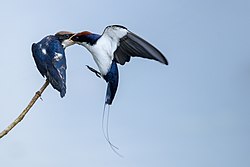Swallow
| Swallow | |
|---|---|
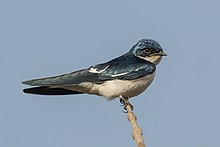
| |
| Pied-winged swallowHirundo leucosoma | |
| Scientific classification | |
| Domain: | Eukaryota |
| Kingdom: | Animalia |
| Phylum: | Chordata |
| Class: | Aves |
| Order: | Passeriformes |
| Suborder: | Passeri |
| Family: | Hirundinidae Rafinesque,1815 |
| Genera | |
|
21, see text | |
Theswallows,martins,andsaw-wings,orHirundinidaeare a family ofpasserinesongbirdsfound around the world on all continents, including occasionally inAntarctica.Highly adapted to aerial feeding, they have a distinctive appearance. The term "swallow" is used as the common name forHirundo rusticain theUK[1]andIreland.[2]Around 90 species ofHirundinidaeare known, divided into 21genera,with the greatest diversity found in Africa, which is also thought to be where they evolved as hole-nesters.[3]They also occur on a number of oceanic islands. A number of European and North American species are long-distancemigrants;by contrast, the West and South African swallows are nonmigratory.
This family comprises two subfamilies:Pseudochelidoninae(theriver martinsof the genusPseudochelidon) andHirundininae(all other swallows, martins, and saw-wings). In the Old World, the name "martin" tends to be used for the squarer-tailed species, and the name "swallow" for the more fork-tailed species; however, this distinction does not represent a real evolutionary separation.[4]In the New World, "martin" is reserved for members of the genusProgne.(These two systems are responsible for the same species being calledsand martinin the Old World and bank swallow in the New World.)
Taxonomy and systematics[edit]
The family Hirundinidae was introduced (as Hirundia) by the FrenchpolymathConstantine Samuel Rafinesquein 1815.[5][6]The Hirundinidae are morphologically unique within the passerines, with molecular evidence placing them as a distinctive lineage within theSylvioidea(Old World warblersand relatives).[7]Phylogenetic analysis has shown that the family Hirundinidae issisterto thecupwingsin the familyPnoepygidae.The two families diverged in the earlyMiocenearound 22 million years ago.[8]
Within the family, a clear division exists between the two subfamilies, the Pseudochelidoninae, which are composed of the two species of river martins,[9][10]and the Hirundininae, into which the remaining species are placed. The division of the Hirundininae has been the source of much discussion, with various taxonomists variouslysplittingthem into as many as 24 genera and lumping them into just 12. Some agreement exists that three core groups occur within the Hirundininae, the saw-wings of the genusPsalidoprocne,the core martins, and the swallows of the genusHirundoand their allies.[11]The saw-wings are the most basal of the three, with the other two clades beingsisterto each other. The phylogeny of the swallows is closely related to evolution of nest construction; the more basal saw-wings use burrows as nest, the core martins have both burrowing (in the Old World members) and cavity adoption (in New World members) as strategies, and the genusHirundoand its allies use mud nests.[12]
The genus levelcladogramshown below is based on amolecular phylogeneticstudy by Drew Schield and collaborators that was published in 2024.[13]The choice ofgeneraand the number of species is taken from the list of birds maintained byFrank Gill,Pamela C. Rasmussenand David Donsker on behalf of theInternational Ornithological Committee(IOC).[14]
| Hirundinidae |
| |||||||||||||||||||||||||||||||||||||||||||||||||||||||||||||||||||||||||||||||||||||||||||||||||||||||||||||||||||||
Description[edit]
The Hirundinidae have an evolutionarily conservative body shape, which is similar across theclade,but is unlike that of otherpasserines.[11]Swallows have adapted to hunting insects on the wing by developing a slender, streamlined body and long, pointed wings, which allow great maneuverability and endurance, as well as frequent periods of gliding. Their body shapes allow for very efficientflight;the metabolic rate of swallows in flight is 49–72% lower than equivalent passerines of the same size.[15]

Swallows have twofoveaein each eye, giving them sharp lateral and frontal vision to help track prey. They also have relatively long eyes, with their length almost equaling their width. The long eyes allow for an increase in visual acuity without competing with the brain for space inside of the head. The morphology of the eye in swallows is similar to that of a raptor.[16]
Like the unrelatedswiftsandnightjars,which hunt in a similar way, they have short bills, but strong jaws and a wide gape. Their body lengths range from about 10–24 cm (3.9–9.4 in) and their weight from about 10–60 g (0.35–2.12 oz). The smallest species by weight may be theFanti sawwing,at a mean body mass of 9.4 g (0.33 oz) while thepurple martinandsouthern martin,which both weigh in excess of 50 g (1.8 oz) on average, rival one another as the heaviest swallows.[17]The wings are long, pointed, and have nine primary feathers. The tail has 12 feathers and may be deeply forked, somewhat indented, or square-ended.[11]A long tail increases maneuverability,[18][19]and may also function as a sexual adornment, since the tail is frequently longer in males.[19]In barn swallows, the tail of the male is 18% longer than those of the female, and females select mates on the basis of tail length.[20]
Their legs are short, and their feet are adapted for perching rather than walking, as the front toes are partially joined at the base. Swallows are capable of walking and even running, but they do so with a shuffling, waddling gait.[21]The leg muscles of the river martins (Pseudochelidon) are stronger and more robust than those of other swallows.[11][21]The river martins have other characteristics that separate them from the other swallows. The structure of thesyrinxis substantially different between the two subfamilies;[9]and in most swallows, the bill, legs, and feet are dark brown or black, but in the river martins, the bill is orange-red and the legs and feet are pink.[11]
The most commonhirundineplumage is glossy dark blue or green above and plain or streaked underparts, often white or rufous. Species thatburrowor live in dry or mountainous areas are often matte brown above (e.g.sand martinandcrag martin). The sexes show limited or nosexual dimorphism,with longer outer tail feathers in the adult male probably being the most common distinction.[22]
The chicks hatch naked and with closed eyes.[23]Fledged juveniles usually appear as duller versions of the adult.[4]
Distribution and habitat[edit]
The family has a worldwidecosmopolitan distribution,breeding on every continent except Antarctica. One species, thePacific swallow,occurs as a breeding bird on a number of oceanic islands in the Pacific Ocean,[24]theMascarene martinbreeds on Reunion and Mauritius in theIndian Ocean,[25]and a number ofmigratoryspecies are common vagrants to other isolated islands and even to some sub-Antarctic islands and Antarctica.[26]Many species have enormous worldwide ranges, particularly the barn swallow, which breeds over most of the Northern Hemisphere and winters over most of the Southern Hemisphere.

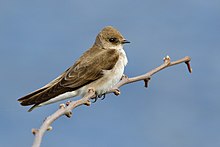
The family uses a wide range of habitats. They are dependent on flying insects, and as these are common over waterways and lakes, they frequently feed over these, but they can be found in any open habitat, including grasslands, open woodland, savanna, marshes, mangroves, and scrubland, fromsea levelto high alpine areas.[11]Many species inhabit human-altered landscapes, including agricultural land and even urban areas. Land-use changes have also caused some species to expand their range, most impressively thewelcome swallow,which began to coloniseNew Zealandin the 1920s, started breeding in the 1950s, and is now a common landbird there.[27]
Species breeding in temperate regionsmigrateduring the winter when their insect prey populations collapse. Species breeding in more tropical areas are often more sedentary, although several tropical species are partial migrants or make shorter migrations. Inantiquity,swallows were thought to havehibernatedin a state oftorpor,or even that they withdrew for the winter under water.Aristotleascribed hibernation not only to swallows, but also to storks and kites. Hibernation of swallows was considered a possibility even by as acute an observer as Rev.Gilbert White,in hisThe Natural History and Antiquities of Selborne(1789, based on decades of observations).[28]This idea may have been supported by the habit of some species to roost in some numbers in dovecotes, nests and other forms of shelter during harsh weather, and some species even entering torpor.[11]There were several reports of suspected torpor in swallows from 1947,[29]such as a 1970 report thatwhite-backed swallowsin Australia may conserve energy this way,[30]but the first confirmed study that they or any passerine entered torpor was a 1988 study onhouse martins.[31]
Behaviour and ecology[edit]

Swallows are excellent flyers and use these skills to feed and attract mates. Some species, such as themangrove swallow,areterritorial,whereas others are not and simply defend their nesting sites. In general, the male selects a nest site, and then attracts a female using song and flight and (dependent on the species) guards his territory. The size of the territory varies depending on the species of swallow; incolonial-nestingspecies, it tends to be small, but it may be much larger for solitary nesters. Outside the breeding season, some species may form large flocks, and species may also roost communally. This is thought to provide protection from predators, such assparrowhawksandhobbies.[11]These roosts can be enormous; one winter-roosting site of barn swallows in Nigeria attracted 1.5 million individuals.[32]Nonsocial species do not form flocks, but recently fledged chicks may remain with their parents for a while after the breeding season. If a human being gets too close to their territory, swallows attack them within the perimeter of the nest. Colonial species may mob predators and humans that are too close to the colony.[33]
Diet and feeding[edit]
For the most part, swallows are insectivorous, taking flying insects on the wing.[11]Across the whole family, a wide range of insects is taken from most insect groups, but the composition of any one prey type in the diet varies by species and with the time of year. Individual species may be selective; they do not scoop up every insect around them, but instead select larger prey items than would be expected by random sampling.[34]In addition, the ease of capture of different insect types affects their rate of predation by swallows.[35]They also avoid certain prey types; in particular, stinging insects such asbeesandwaspsare generally avoided. In addition to insect prey, a number of species occasionally consume fruits and other plant matter. Species in Africa have been recorded eating the seeds ofAcaciatrees, and these are even fed to the young of thegreater striped swallow.[11][36]
The swallows generally forage for prey on the wing, but they on occasion snap prey off branches or on the ground. The flight may be fast and involve a rapid succession of turns and banks when actively chasing fast-moving prey; less agile prey may be caught with a slower, more leisurely flight that includes flying in circles and bursts of flapping mixed with gliding. Where several species of swallows feed together, they separate into differentnichesbased on height off the ground, some species feeding closer to the ground and others feeding at higher levels.[37]Similar separation occurs where feeding overlaps withswifts.Niche separationmay also occur with the size of prey chosen.[37]
Breeding[edit]
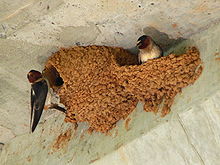
The more primitive species nest in existing cavities, for example in an oldwoodpeckernest, while other species excavate burrows in soft substrate such as sand banks.[11]Swallows in the generaHirundo,Ptyonoprogne,Cecropis,Petrochelidon,AtronanusandDelichonbuild mud nests close to overhead shelter in locations that are protected from both the weather and predators. The mud-nesters are most common in the Old World, particularly Africa, whereas cavity-nesters are more common in the New World. Mud-nesting species in particular are limited in areas of high humidity, which causes the mud nests to crumble. Many cave-, bank-, and cliff-dwelling species of swallows nest in large colonies. Mud nests are constructed by both males and females, and amongst the tunnel diggers, the excavation duties are shared, as well. In historical times, the introduction of man-made stone structures such as barns and bridges, together with forest clearance, has led to an abundance of colony sites around the globe, significantly increasing the breeding ranges of some species. Birds living in large colonies typically have to contend with bothectoparasitesand conspecificnest parasitism.[38][39]In barn swallows, old mated males and young unmated males benefit from colonial behaviour, whereas females and mated young males likely benefit more from nesting by themselves.[40]
Pairs of mated swallows are monogamous,[41]and pairs of nonmigratory species often stay near their breeding area all year, though the nest site is defended most vigorously during the breeding season. Migratory species often return to the same breeding area each year, and may select the same nest site if they were previously successful in that location. First-year breeders generally select a nesting site close to where they were raised.[42]The breeding of temperate species is seasonal, whereas that of subtropical or tropical species can either be continuous throughout the year or seasonal. Seasonal species in the subtropics or tropics usually time their breeding to coincide with the peaks in insect activity, which is usually the wet season, but some species, such as thewhite-bibbed swallow,nest in the dry season to avoid flooding in their riverbank nesting habitat.[11]All swallows defend their nests from egg predators, although solitary species are more aggressive towards predators than colonial species.[43]Overall, the contribution of male swallows towards parental care is the highest of any passerine bird.[11]
Theeggsof swallows tend to be white, although those of some mud-nesters are speckled. The typicalclutch sizeis around four to five eggs in temperate areas and two to three eggs in the tropics. Theincubationduties are shared in some species, and in others the eggs are incubated solely by the females. Amongst the species where the males help with incubation, their contribution varies amongst species, with some species such as the cliff swallow sharing the duties equally and the female doing most of the work in others. Amongst the barn swallows, the male of the American subspecies helps (to a small extent), whereas the European subspecies does not. Even in species where the male does not incubate the eggs, he may sit on them when the female is away to reduce heat loss (this is different from incubation as that involves warming the eggs, not just stopping heat loss). Incubation stints last for 5–15 minutes and are followed by bursts of feeding activity. From laying, swallow eggs take 10–21 days to hatch, with 14–18 days being more typical.[11]
The chicks of swallows hatch naked, generally with only a few tufts of down. The eyes are closed and do not fully open for up to 10 days. The feathers take a few days to begin to sprout, and the chicks are brooded by the parents until they are able tothermoregulate.On the whole, they develop slowly compared to other passerine birds. The parents do not usually feed the chicks individual insects, but instead feed a bolus of food comprising 10–100 insects. Regardless of whether the species has males that incubate or brood the chicks, the males of all hirundines help feed the chicks. When the youngfledgeis difficult to determine, as they are enticed out of the nest after three weeks by parents, but frequently return to the nest afterwards to roost.[11]
Calls[edit]
Swallows are able to produce many differentcallsor songs, which are used to express excitement, to communicate with others of the same species, during courtship, or as an alarm when a predator is in the area. The songs of males are related to the body condition of the bird and are presumably used by females to judge the physical condition and suitability for mating of males.[44]Begging calls are used by the young when soliciting food from their parents. The typical song of swallows is a simple, sometimes musical twittering.
Status and conservation[edit]
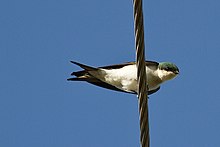
Species of hirundine that arethreatenedwithextinctionare generally endangered due tohabitat loss.This is presumed to be the reason behind the decline of thecritically endangeredwhite-eyed river martin,a species that is only known from a few specimens collected inThailand.The species presumably breeds in riverbanks, a much diminished habitat in Southeast Asia. As the species has not been reliably seen since 1980, it may already be extinct.[45]Two insular species, theBahama swallowandgolden swallow,have declined due to forest loss and also competition withintroduced speciessuch as starlings and sparrows, which compete with these swallows for nesting sites. The golden swallow formerly bred on the island ofJamaica,but was last seen there in 1989 and is now restricted to the island ofHispaniola.[46]
Relationship with humans[edit]


Swallows are tolerated by humans because of their beneficial role as insect eaters, and some species have readily adapted to nesting in and around human habitation. The barn swallow andhouse martinnow rarely use natural sites. Thepurple martinis also actively encouraged by people to nest around humans and elaborate nest boxes are erected. Enough artificial nesting sites have been created that the purple martin now seldom nests in natural cavities in the eastern part of its range.[51]
Because of the long human experience with these conspicuous species, many myths and legends have arisen as a consequence, particularly relating to the barn swallow.[11]Roman historianPliny the Elderdescribed a use of painted swallows to deliver a report of the winning horses at a race.[52]There is also theKoreanfolktale ofHeungbu and Nolbu,which teaches a moral lesson about greed and altruism through the mending of a swallow's broken leg.[53]
During the 19th century,Jean Desbouvrieattempted to tame swallows and train them for use as messenger birds, as an alternative towar pigeons.The swallows would have a light load of course, as a laden swallow could only travel about half as far as an unladen swallow in the same trip. He succeeded in curbing the migratory instinct in young birds and persuaded the government of France to conduct initial testing, but further experimentation stalled.[52][54]Subsequent attempts to train homing behaviour into swallows and other passerines had difficulty establishing a statistically significant success rate, although the birds have been known to trap themselves in a cage repeatedly to get to the bait.[52]
According to asailing superstition,swallows are a good omen to those at sea. This probably arose from the fact that swallows are land-based birds, so their appearance informs a sailor that he or she is close to shore.[55] An oldterm of veneryfor swallows is a "flight" or "sweep".[56]
Species list[edit]
The family contains 90 species in 21 genera.[14]
| Image | Genus | Species |
|---|---|---|
 |
PseudochelidonHartlaub, 1861 |
|
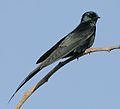 |
PsalidoprocneCabanis, 1850 |
|
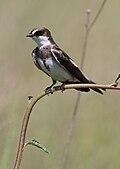 |
NeophedinaRoberts, 1922 |
|
 |
PhedinopsisWolters, 1971 |
|
 |
PhedinaBonaparte, 1855 |
|
 |
RipariaForster,T, 1817 |
|
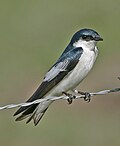 |
TachycinetaCabanis, 1850 |
|
 |
AtticoraGould, 1842 |
|
 |
PygochelidonBaird, SF, 1971 |
|
 |
AlopochelidonRidgway, 1903 |
|
 |
OrochelidonRidgway, 1903 |
|
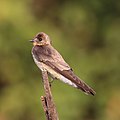 |
StelgidopteryxBaird, SF, 1858 |
|
 |
ProgneBoie, F, 1826 |
|
 |
PseudhirundoRoberts, 1922 |
|
 |
CheramoecaCabanis, 1850 |
|
 |
PtyonoprogneReichenbach, 1850 |
|
 |
HirundoLinnaeus, 1758 |
|
 |
DelichonMoore, F, 1854 |
|
 |
CecropisBoie, F, 1826 |
|
| AtronanusDe Silva, 2018 |
| |
 |
PetrochelidonCabanis, 1850 |
|
References[edit]
- ^"Swallow Bird Facts".RSPB.Retrieved8 May2024.
- ^"Swallow".Birdwatch Ireland.Retrieved8 May2024.
- ^Angela Turner; Chris Rose (2010).A Handbook to the Swallows and Martins of the World.A&C Black. p. 12.ISBN9781408131725.
- ^abTurner, Angela; Rose, Chris (1989).Swallows and martins: an identification guide and handbook.Houghton-Mifflin.ISBN978-0-395-51174-9.
- ^Rafinesque, Constantine Samuel(1815).Analyse de la nature ou, Tableau de l'univers et des corps organisés(in French). Vol. 1815. Palermo: Self-published. p. 68.
- ^Bock, Walter J. (1994).History and Nomenclature of Avian Family-Group Names.Bulletin of the American Museum of Natural History. Vol. 222. New York: American Museum of Natural History. pp. 149, 252.hdl:2246/830.
- ^Alström, Per; Olsson, Urban; Lei, Fumin (2013)."A review of the recent advances in the systematics of the avian superfamily Sylvioidea".Chinese Birds.4(2): 99–131.Bibcode:2013AvRes...4...99A.doi:10.5122/cbirds.2013.0016.
- ^Oliveros, C.H.; et al. (2019)."Earth history and the passerine superradiation".Proceedings of the National Academy of Sciences of the United States.116(16): 7916–7925.Bibcode:2019PNAS..116.7916O.doi:10.1073/pnas.1813206116.PMC6475423.PMID30936315.
- ^abMayr, E.; Amadon, D (1951)."A Classification of Recent Birds"(PDF).American Museum Novitates(1496): 16.
- ^Sheldon, Frederick H.; Whittingham, Linda A.; Moyle, Robert G.; Slikas, Beth; Winkler, David W. (April 2005)."Phylogeny of swallows (Aves: Hirundinidae) estimated from nuclear and mitochondrial DNA sequences".Molecular Phylogenetics and Evolution.35(1): 254–270.Bibcode:2005MolPE..35..254S.doi:10.1016/j.ympev.2004.11.008.PMID15737595.
- ^abcdefghijklmnopTurner, Angela K. (2004)."Family Hirundinidae (Swallows and Martins)".In del Hoyo, J.; Elliott, A.; Christie, D.A. (eds.).Handbook of the Birds of the World.Vol. 9: Cotingas to Pipits and Wagtails. Barcelona, Spain: Lynx Edicions. pp. 602–685.ISBN978-84-87334-69-6.
- ^Winkler, D. W.; Sheldon, F. H. (1993)."Evolution of nest construction in swallows (Hirundinidae): a molecular phylogenetic perspective".Proceedings of the National Academy of Sciences.90(12): 5705–5707.Bibcode:1993PNAS...90.5705W.doi:10.1073/pnas.90.12.5705.ISSN0027-8424.PMC46790.PMID8516319.
- ^Schield, D.R.; Brown, C.E.; Shakya, S.B.; Calabrese, G.M.; Safran, R.J.; Sheldon, F.H. (2024). "Phylogeny and historical biogeography of the swallow family (Hirundinidae) inferred from comparisons of thousands of UCE loci".Molecular Phylogenetics and Evolution.197:108111.doi:10.1016/j.ympev.2024.108111.PMID38801965.
- ^abGill, Frank;Donsker, David;Rasmussen, Pamela,eds. (December 2023)."Swallows".IOC World Bird List Version 14.1.International Ornithologists' Union.Retrieved27 May2024.
- ^Hails, C.J (1979). "A comparison of flight energetics in hirundines and other birds".Comparative Biochemistry and Physiology Part A: Physiology.63(4): 581–585.doi:10.1016/0300-9629(79)90199-3.
- ^Tyrrell, Luke P.; Fernández-Juricic, Esteban (2017). "The hawk-eyed songbird: Retinal morphology, eye shape, and visual fields of an aerial insectivore".The American Naturalist.189(6): 709–717.doi:10.1086/691404.ISSN0003-0147.PMID28514631.S2CID3923166.
- ^Dunning, John B. Jr., ed. (2008).CRC Handbook of Avian Body Masses(2nd ed.). CRC Press.ISBN978-1-4200-6444-5.
- ^Norberg, R. Ake (1994). "Swallow Tail Streamer is a Mechanical Device for Self Deflection of Tail Leading Edge, Enhancing Aerodynamic Efficiency and Flight Manoeuvrability".Proceedings of the Royal Society B.257(1350): 227–233.Bibcode:1994RSPSB.257..227N.doi:10.1098/rspb.1994.0119.S2CID86592049.
- ^abBuchanan, Katherine L.; Evans, Matthew R. (2000)."The effect of tail streamer length on aerodynamic performance in the barn swallow".Behavioral Ecology.11(2): 228–238.doi:10.1093/beheco/11.2.228.hdl:10536/DRO/DU:30100792.
- ^Møller, Anders pape (1992)."Sexual selection in the monogamous barn swallow (Hirundo rustica). II. Mechanisms of sexual selection ".Journal of Evolutionary Biology.5(4): 603–624.doi:10.1046/j.1420-9101.1992.5040603.x.S2CID85260912.
- ^abGaunt, Abbot (1969)."Myology of the Leg in Swallows".Auk.86(1): 41–53.doi:10.2307/4083540.JSTOR4083540.
- ^Bańbura, Jerzy (1986). "Sexual dimorphism in wing and tail length as shown by the SwallowHirundo rustica".Journal of Zoology.201(1): 131–136.doi:10.1111/j.1469-7998.1986.tb03625.x.
- ^Gill, Frank B. (1995).Ornithology.W. H. Freeman. p. 434.ISBN978-0-7167-2415-5.
- ^Pratt, H.; Bruner, P; Berrett, D. (1987).The Birds of Hawaii and the Tropical Pacific.Princeton:Princeton University Press.p. 229.ISBN978-0-691-08402-2.
- ^Sinclair, Ian; Olivier Langrand (2005).Birds of the Indian Ocean Islands.Struik. p. 118.ISBN978-1-86872-956-2.
- ^Korczak-Abshire, Małgorzata; Lees, Alexander; Jojczyk, Agata (2001). "First documented record of barn swallow (Hirundo rustica) in the Antarctic ".Polish Polar Research.32(4): 355–360.doi:10.2478/v10183-011-0021-9.
- ^Tarburton, M.K. (1993). "A Comparison of the Breeding Biology of the Welcome Swallow in Australia and Recently Colonized New Zealand".Emu.93(1): 34–43.Bibcode:1993EmuAO..93...34T.doi:10.1071/MU9930034.
- ^In 1878, Dr. Elliott Coues, listed titles of 182 papers dealing with the hibernation of swallows ((USGS: Northern Prairie Wildlife Research Center) "Early ideas about migration"Archived2008-08-27 at theWayback Machine).
- ^Lariewski, Robert C.; Thompson, Henry J. (1965)."Field Observation of Torpidity in the Violet-Green Swallow"(PDF).Condor.68(1): 102–103.doi:10.2307/1365178.JSTOR1365178.
- ^Serventy, D. L. (1970)."Torpidity in the White-backed Swallow".Emu.70(1): 27–28.Bibcode:1970EmuAO..70...27S.doi:10.1071/mu970027a.
- ^Prinzinger, R; Siedle, K (1988). "Ontogeny of metabolism, thermoregulation and torpor in the house martinDelichon u. urbica(L.) and its ecological significance ".Oecologia.76(2): 307–312.Bibcode:1988Oecol..76..307P.doi:10.1007/BF00379969.PMID28312213.S2CID52596.
- ^Bijlsma, R (2003)."A Barn SwallowHirundo rusticaroost under attack: timing and risks in the presence of African HobbiesFalco cuvieri"(PDF).Ardea.93(1): 37–48. Archived fromthe original(PDF)on 2008-10-31.
- ^Shields, William (1984). "Barn swallow mobbing: Self-defence, collateral kin defence, group defence, or parental care?".Animal Behaviour.32(1): 132–148.doi:10.1016/s0003-3472(84)80331-0.S2CID53193659.
- ^McCarty, John P.; David W. Winkler (1999)."Foraging Ecology and Diet Selectivity of Tree Swallows Feeding Nestlings"(PDF).Condor.101(2): 246–254.doi:10.2307/1369987.JSTOR1369987.
- ^Hespenheide, Henry A. (1975). "Selective predation by two swifts and a swallow in Central America".Ibis.117(1): 82–99.doi:10.1111/j.1474-919X.1975.tb04189.x.
- ^Underhill, L; Hofmeyr, J (2007). "Barn SwallowsHirundo rusticadisperse seeds of RooikransAcacia cyclops,an invasive alien plant in the Fynbos Biome ".Ibis.149(3): 468–471.doi:10.1111/j.1474-919X.2007.00598.x.
- ^abOrłowski, Grzegorz; Karg, Jerzy (2013). "Diet breadth and overlap in three sympatric aerial insectivorous birds at the same location".Bird Study.60(4): 475–483.Bibcode:2013BirdS..60..475O.doi:10.1080/00063657.2013.839622.
- ^Brown, C; Brown, M (1986)."Ectoparasitism as a Cost of Coloniality in Cliff Swallows (Hirundo pyrrhonota) ".Ecology.67(5): 1206–1218.Bibcode:1986Ecol...67.1206B.doi:10.2307/1938676.JSTOR1938676.
- ^Brown, C (1984). "Laying Eggs in a Neighbor's Nest: Benefit and Cost of Colonial Nesting in Swallows".Science.224(4648): 518–519.Bibcode:1984Sci...224..518B.doi:10.1126/science.224.4648.518.PMID17753777.S2CID21128259.
- ^Møller, Anders Pape (1987). "Advantages and disadvantages of coloniality in the swallow,Hirundo rustica".Animal Behaviour.35(3): 819–832.doi:10.1016/S0003-3472(87)80118-5.ISSN0003-3472.S2CID53185342.
- ^HirundinidaeArchived2002-05-04 at theWayback Machine.eeb.cornell.edu
- ^Swallows (Hirundinidae)Archived2009-01-29 at theWayback Machine.Answers
- ^Snapp, B (1976)."Colonial Breeding in the Barn Swallow (Hirundo rustica) and Its Adaptive Significance"(PDF).The Condor.78(4): 471–480.doi:10.2307/1367096.JSTOR1367096.
- ^Saino, N; Galeotti, P; Sacchi, R; Møller, A (1997)."Song and immunological condition in male barn swallows (Hirundo rustica) ".Behavioral Ecology.8(94): 364–371.doi:10.1093/beheco/8.4.364.
- ^Tobias, Joe (2000)."Little known Oriental Bird: White-eyed River-Martin: 1".Oriental Bird Club Bulletin.31.
- ^Townsend, Jason; Esteban Garrido; Danilo A. Mejia (2008). "Nests and Nesting Behavior of Golden Swallow (Tachycineta euchrysea) in Abandoned Bauxite Mines in the Dominican Republic ".Wilson Journal of Ornithology.120(4): 867–871.doi:10.1676/08-001.1.S2CID85973776.
- ^"National symbols of Estonia".The Estonia Institute.Archivedfrom the original on 9 November 2007.Retrieved27 November2007.
- ^"Gallery of Barn Swallow stamps from Bird-Stamps.org".Archived from the original on 2020-06-09.Retrieved2022-07-21.
{{cite web}}:CS1 maint: unfit URL (link) - ^The American Topical Association lists more than 1000 depictions of swallows and martins on postage stamps around the world. See[1]Archived2020-03-31 at theWayback Machine
- ^Wikibooks: World Catalogue of Stamps[permanent dead link]
- ^Jackson, Jerome; Tate, James Jr. (1974). "An Analysis of Nest Box Use by Purple Martins, House Sparrows, and Starlings in Eastern North America".The Wilson Bulletin.86(4): 435–449.JSTOR4160543.
- ^abcBrian, P.W. (1955).Bird Navigation.Cambridge University Press. pp. 57–58.Retrieved2009-03-01.
- ^"More than just a bird: Korea.net: The official website of the Republic of Korea".
- ^Anonymous (1889).Zoologist: A Monthly Journal of Natural History, ser.3 v.13.J. Van Voorst. pp. 398–399.Retrieved2009-03-01.
- ^Eyers, Jonathan (2011).Don't Shoot the Albatross!: Nautical Myths and Superstitions.A&C Black, London, UK.ISBN978-1-4081-3131-2.
- ^"Animal Congregations, or What Do You Call a Group of.....?".USGS.gov.Northern Prairie Wildlife Research Center. Archived fromthe originalon 20 March 2015.Retrieved13 September2011.
External links[edit]
- Swallow videoson the Internet Bird Collection
- The evolution of nest construction in swallows (Hirundinidae) is associated with the decrease of clutch size[permanent dead link]paper in Linzer Biologische Beiträge
 Texts on Wikisource:
Texts on Wikisource:
- "Swallows".The New Student's Reference Work.1914.
- Newton, Alfred(1911). "Martin".InChisholm, Hugh(ed.).Encyclopædia Britannica(11th ed.). Cambridge University Press.
- Newton, Alfred(1911). "Swallow".Encyclopædia Britannica(11th ed.).
- "Swallow".New International Encyclopedia.1905.


